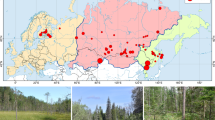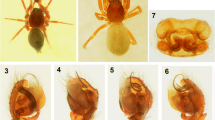Abstract
A brief review of the geometrid fauna of the large island of Tasmania and a simple analysis of its conservation status and threats are presented. The fauna comprises 310 species of which Ennominae contribute slightly less than half the total and Larentiinae one third; 23% of the geometrid fauna is endemic at species level. Mixed eucalypt-rainforest is identified as the richest wet forest habitat in geometrid species. Using distribution data at 10 km resolution, the most widespread and most restricted taxa are identified. The conservation status of Lepidoptera living above 800 m is relatively good. However, coastal species and those associated with herb-rich native grasslands are under some pressure from habitat change. Three species of geometrid moths are listed as threatened in Tasmania's Threatened Species Protection Act 1995 but several others may qualify for listing.
Similar content being viewed by others
References
Bashford R. 2001. The spread and impact of the introduced vespine wasps Vespula germanica (F.)and Vespula vulgaris (L.)(Hymenoptera: Vespidae: Vespinae)in Tasmania.Aust. Entomol.28: 1–12.
Bridle K.L. and Kirkpatrick J.B.1999.Comparative effects of stock and wild vertebrate herbivore grazing on treeless subalpine vegetation,Eastern Central Plateau,Tasmania.Aust. J.Bot.47: 817–834.
Brown M.J., Balmer J. and Podger F.D.2002.Vegetation change over 20 years at Bathurst Harbour,Tasmania.Aust. J.Bot.50: 499–510.
Burnley I. and Murphy P.2004.Sea Change: Movement from Metropolitan to Arcadian Australia.University of NSW Press, Sydney,271 pp.
CSIRO.2001.Climate change projections for Australia.http: // www.dar.csiro.au/publications/projections2001.pdf.
Driessen M.M.1999.Management of threatened invertebrates of the Tasmanian wilderness world heritage area.In: Ponder W. and Lunney D.(eds),The Other 99%: The Conservation and Biodiversity of Invertebrates.The Zoological Society of New South Wales,Mosman,pp.333–340.
Edwards E.D. and McQuillan P.B.1998.Lepidoptera.In: Driessen M.M., Comfort M.D., Jackson J., Balmer J., Richardson A.M.M. and McQuillan P.B.(eds),Wilderness Ecosystems Baseline Studies 1990–1993. WEBS. Pelion Plains – Mt Ossa,Parks and Wildlife Service,Hobart,pp.67–73.
Elliott H.J., Bashford R. and Palzer C. 1980. Biology of Stathmorrhopa aphotista Turner (Lepidoptera: Geometridae), a defoliator of Eucalyptus spp. in Southern Tasmania. Aust. Forest. 43: 81–86.
Guest E.1887.A classiffied list of Geometrina found around Balhannah,with notes on species.Trans.R.Soc.South Aust. 9: 126–141.
Hopkins G.W., Thacker J.I., Dixon A.F.G., Waring P. and Telfer M.G.2002.Identifying rarity in insects: the importance of host plant range.Biol.Conserv. 105: 293–307.
Kiernan K.2002.Conservation,timber and perceived values at Mt Field,Tasmania.In: Dargavel J., Gaughwin D. and Libbis B.(eds),Australia's Ever-changing Forests V: Proceedings of the Fifth National Conference on Australian Forest History,Centre for Resource and Environmental Studies,The Australian National University, Canberra,pp. 209–227.
Kirkpatrick J.B.1991.The magnitude and signi cance of land clearance in Tasmania in the 1980s.Tasforests 3: 11–14.
Kirkpatrick J.B. and Fowler M.1998.Locating likely glacial forest refugia in Tasmania using palynological and ecological information to test alternative climatic models.Biol.Conserv.85: 171–182.
Lindenmayer D.B., Cunningham R.B., Donnelly C.F. and Franklin J.F.2000.Structural features of old-growth Australian montane ash forests.Forest.Ecol.Manag. 134: 189–204.
Lindenmayer D. and McCarthy M.A.2002.Congruence between natural and human forest disturbance: a case study from Australian montane ash forests.For.Ecol.Manag. 155: 319–335.
McFarland N.1988.Portraits of South Australian geometrid moths.Allan Press, Kansas.
McQuillan P.B.1984.A new genus for Chlenias fucata Felder and Rogenhofer (Lepidoptera: Geometridae: Ennominae) and a new Tasmanian species.J.Aust.Entomol.Soc.23: 297–306.
McQuillan P.B.1985.A taxonomic revision of the Australian autumn gum moth genus Mnesampela Guest (Lepidoptera: Geometridae,Ennominae).Entomol.scand. 16: 175–202.
McQuillan P.B.1999.The effect of changes in Tasmanian grasslands on the geometrid moth tribe Xanthorhoini Geometridae: Larentiinae.In: Ponder W. and Lunney D.(eds), The Other 99%.The Conservation and Biodiversity of Invertebrates.Transactions of the Royal Zoological Society of New South Wales,Mosman,pp.121–128.
McQuillan P.B. and Edwards E.D.1996.Geometridae.In: Nielsen E.S., Edwards E.D. and Rangsi V.(eds),Checklist of the Lepidoptera of Australia.CSIRO, Melbourne,pp. 200–228, 355–357.
Mendel L.C. and Kirkpatrick J.B.2002.Historical progress of biodiversity conservation in the protected-area system of Tasmania,Australia.Conserv.Biol.16: 1520–1529.
O'Dwyer C. and Attiwill P.M.1999.A comparative study of habitats of the Golden Sun Moth Synemon plana Walker (Lepidoptera: Castniidae): implications for restoration.Biol. Conserv.89: 131–141.
RFA 2002. Tasmanian Regional Forest Agreement.http//www.a.a.gov.au,accessed 5 May 2004.
Richardson A.M.M., Swain R. and Wong V.1998.Relationship between the crustacean and molluscan assemblages of Tasmanian saltmarshes and the vegetation and soil conditions.Mar.Freshwater Res.49: 785–799.
RPDC (Resource Planning and Development Commission) 2003. State of the Environment Tasmania 2003. http//www.rpdc.tas.gov.uu/soer, accessed 5 May 2004.
Schmidt O. 2002. A revision of the genus Chaetolopha Warren (Lepidoptera: Geometridae: Larentiinae)with a description of Parachaetolopha, gen. nov. Invertebr. Syst. 16: 703–733.
Sinclair L.J. 2002. Distribution and conservation requirements of Notoreas sp., an unnamed geometrid moth on the Taranaki coast, North Island, New Zealand. N.Z.J.Zool. 29: 311–322.
Specht R.L.1963.Dark Island heath (Ninety-Mile Plain,South Australia).7.The eect of fertilizers on composition and growth,1950–60.Aust.J.Bot.11: 67–94.
Turner A.J.1926a.New and little known Tasmanian Lepidoptera.Pap.Proc.R.Soc Tasmania 1925: 81–117.
Turner A.J.1926b.A revision of Lepidoptera of Tasmania. Pap.Proc.R.Soc.Tasmania 1925: 118–151.
Turner A.J.1928.A revision of the Lepidoptera of Tasmania. Part II.Pap.Proc.R.Soc.Tasmania 1927: 29–65.
Turner A.J.1939.A second revision of the Lepidoptera of Tasmania.Pap.Proc.R.Soc.Tasmania 1938: 57–115.
Young C.J. and McQuillan P.B.2003.Redescription and life-cycle of Archephanes zalosema Turner,1926 (Lepidoptera: Geometridae: Ennominae), a specialist on Winteraceae.Insect Syst.Evol.34: 81–94.
Author information
Authors and Affiliations
Rights and permissions
About this article
Cite this article
McQuillan, P.B. An overview of the Tasmanian geometrid moth fauna (Lepidoptera: Geometridae) and its conservation status. Journal of Insect Conservation 8, 209–220 (2004). https://doi.org/10.1023/B:JICO.0000045819.19676.37
Issue Date:
DOI: https://doi.org/10.1023/B:JICO.0000045819.19676.37




